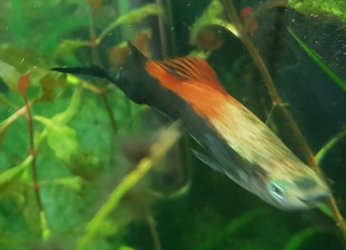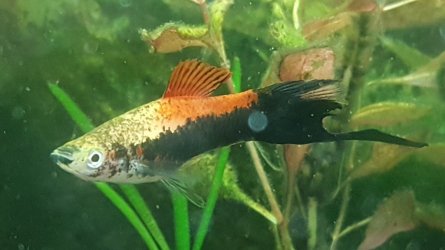OK... this is an excerpt of relevant discussion from the thread linked above. What is described is identical to the progression I have observed in my two fish. Someone in the thread linked some pictures on photobucket that I cannot access.
RedAngelFish
03-02-2011, 02:10 PM
I hear there is a possibility of cancer in the black strain of swordtails. Is it advisable to put blacks in with other fish? Can it be transmitted?
starrynightxxi
03-02-2011, 02:40 PM
cancer is not a contagious disease, though I suppose if you have other swords or platies in the same you might breed a tendency towards cancer into those lines...
RedAngelFish
03-02-2011, 03:14 PM
Thank you STARRY, Can I say DAHHHHHHHHHHHHHHHH? I appreciate your quick responce...........
yimes
03-02-2011, 04:01 PM
No it can not be transmitted and my understanding and research is that it is not black (body) swordtails so much as swordtails that have black fins. I have kept black swordtails that have clear fins or streaks of black and they do fine. I have also kept showa and painted swords that when they develop solid black fins they have developed cancer. In my experience the color of the body is not the danger it is the color of the fin.
vegetarian_great_white
03-02-2011, 04:16 PM
Are they subject to a particular type of cancer or in a particular organ, do you know?
yimes
03-02-2011, 04:25 PM
The cancer is like melanoma, a tumor at the site of the black tail fin. The fin gets thick (the tumor growing) and eventually dies/falls off. I don't know about
"spreading" to organs but I am pretty sure it is akin to skin cancer so I don't see why it could not. I have had swords with black tails develop cancer and live for many months or longer. Of course they lose their tail fins. BTW when I say tail I do not mean sword. I probably have one or two currently so I will see if I can get a good pic later tonight. It is not an epidemic, and for me seems to only effect fish with solid black tail fins and then not all of them.
vegetarian_great_white
03-02-2011, 07:12 PM
Thanks. I am doing some reading now. Some other interesting findings: The melanoma is associated with larger male size and more aggressive males in wild swords. The ones with black spots in the tail (which presumably are the origin of those black fin/tail phenotypes that are more cancer-prone) are favored by the females. Wouldn't be surprized if large and aggressive males are getting more females (maybe they are also the ones with black fin spots). That is some explanation why evolution did not get rid of these guys.
Now I am intrigued by this model. A lot of the time, the genes related to dermal patterning are also involved in the making of other collagenous tissues. As I am reading on, I recognize some of the proteins (eg. osteopontin) they identifed as related to this cancer. I am wondering if swordtail would be a good model to study connective tissue problems. Sorry, I digress. It is fascinating.
fishfarmer2000
03-03-2011, 09:21 AM
The advice I got and followed on pure black swords was to use black males only for a generation or two to keep the bodies black but when the black starts on the fins to use black females and pure red males the next generation. This does two things- it reduces the black on the fins and it also makes a pretty, black fish with red fins. I think these are called black berlins.
Steve
UncleDare
03-03-2011, 11:59 AM
Black in the fins isn't necessarily connected to cancer; Wag Swords do not get cancerous growths. However, a quick rule of thumb is that any black on the body that is solid or velvety in appearance does have a higher probability of cancer. Black swords generally have some green iridescent spots on them, and are less likely to become cancerous than something like Tuxedo, which is invariably cancerous on the body in a homozygous genetic state. The marble patterns actually come from two different genes; one is related to the Black sword and shows some iridescence, the other has no iridescence in it, and is what you see in "Painted" patterns like the one above. This one does seem to have a greater tendency toward cancer in the fins or at the base of the fins, though I have seen specimens with cancer on the body. It is sometimes harder to spot on the body.
You can also get melanomas in some types of Albino Swords! An albino combined with the gene for Tuxedo can, as an adult, develop deeply embedded melanomas, despite the fact that albinism is caused by blocking the production of enzymes necessary to produce melanin. This is why they were used in a lot of cancer research back in the 1960s. There is an actual gene connected to the cancer, and this discovery was very important back then.
vegetarian_great_white
03-03-2011, 04:48 PM
What I read was for Helleri type swords (Montezumae and Cortezi; is it OK to call them Helleri?) although it seems all Xiphophorus are fair game. It may not be generalized to black fins if spotted-tail is associated with cancer in certain species of swords. It would depend on what morph that gene will produce in a hybrid. Your example (eg. Albino + Tuxedo) is saying that the oncogene does not consistently produce the black-fin morphology (assuming it comes from Tuxedo) and that there are other genes that can give you black fins. So it is not a reliable way of predicting cancer in these fish. Is the black fin in Wag sword coming from a platy that is not cancer-prone?
The Albino case may also have something to do with external factors such as higher susceptibility to DNA damage from UV light while the spot-tail sword may be inherently disposed to grow tumors (like growing moles). I am sure they must have studied this under UV and non-UV conditions. Do you know what was found?






